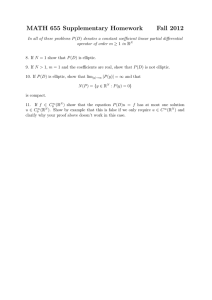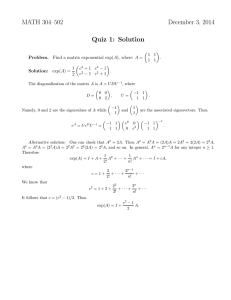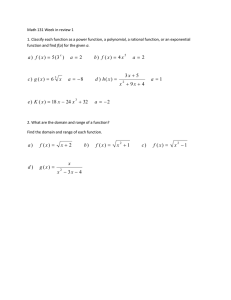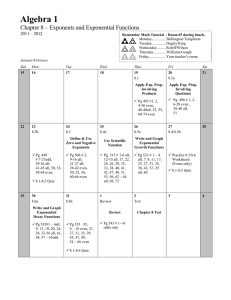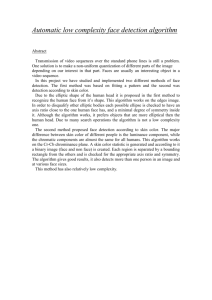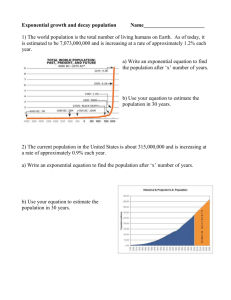Document 10767350
advertisement
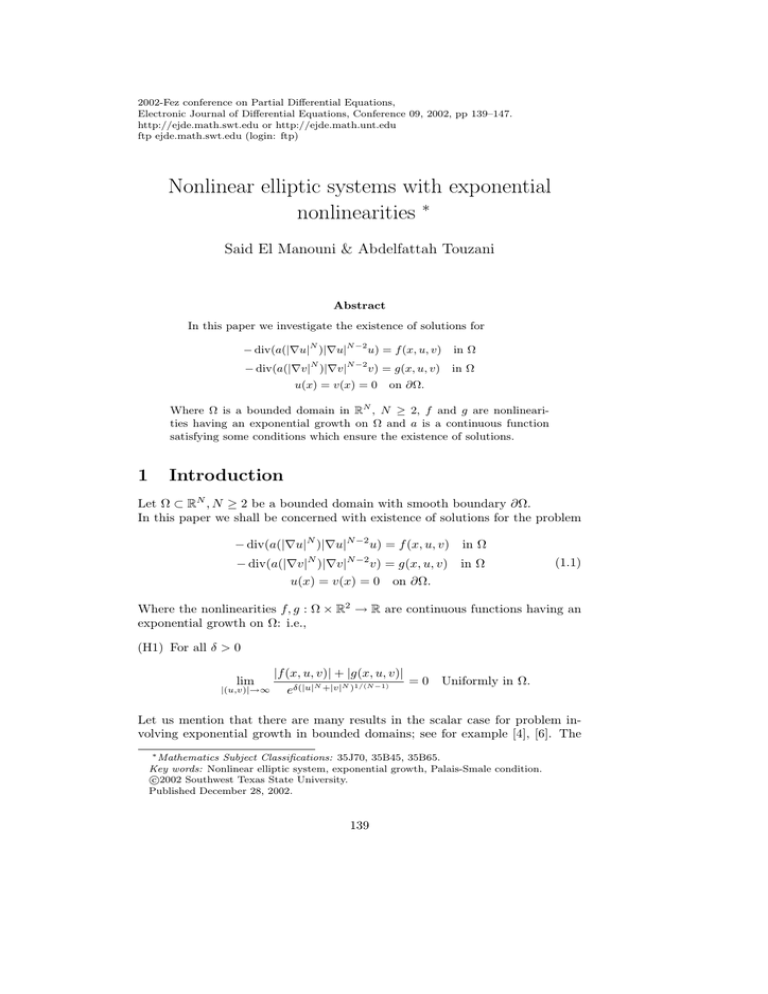
2002-Fez conference on Partial Differential Equations,
Electronic Journal of Differential Equations, Conference 09, 2002, pp 139–147.
http://ejde.math.swt.edu or http://ejde.math.unt.edu
ftp ejde.math.swt.edu (login: ftp)
Nonlinear elliptic systems with exponential
nonlinearities ∗
Said El Manouni & Abdelfattah Touzani
Abstract
In this paper we investigate the existence of solutions for
− div(a(|∇u|N )|∇u|N −2 u) = f (x, u, v)
N
N −2
− div(a(|∇v| )|∇v|
v) = g(x, u, v)
u(x) = v(x) = 0
in Ω
in Ω
on ∂Ω.
Where Ω is a bounded domain in RN , N ≥ 2, f and g are nonlinearities having an exponential growth on Ω and a is a continuous function
satisfying some conditions which ensure the existence of solutions.
1
Introduction
Let Ω ⊂ RN , N ≥ 2 be a bounded domain with smooth boundary ∂Ω.
In this paper we shall be concerned with existence of solutions for the problem
− div(a(|∇u|N )|∇u|N −2 u) = f (x, u, v) in Ω
− div(a(|∇v|N )|∇v|N −2 v) = g(x, u, v) in Ω
u(x) = v(x) = 0 on ∂Ω.
(1.1)
Where the nonlinearities f, g : Ω × R2 → R are continuous functions having an
exponential growth on Ω: i.e.,
(H1) For all δ > 0
lim
|(u,v)|→∞
|f (x, u, v)| + |g(x, u, v)|
= 0 Uniformly in Ω.
eδ(|u|N +|v|N )1/(N −1)
Let us mention that there are many results in the scalar case for problem involving exponential growth in bounded domains; see for example [4], [6]. The
∗ Mathematics Subject Classifications: 35J70, 35B45, 35B65.
Key words: Nonlinear elliptic system, exponential growth, Palais-Smale condition.
c
2002
Southwest Texas State University.
Published December 28, 2002.
139
140
Nonlinear elliptic systems with exponential nonlinearities
objective of this paper is to extend these results to a more general class of elliptic systems using variational method. Here we will make use the approach
stated by Rabinowitz [8].
Note that for nonlinearities having polynomial growth, several results of such
problem have been established. We can cite, among others, the articles: [9] and
[10]. In order to prove the compactness condition of the functional associated
to a problem (1.1) we assume the following hypothesis
µ
µ
∂F
∂F
(H2) u ∂F
∂u ≥ 2 F and v ∂v ≥ 2 F , where F = F (x, u, v) and such that ∂u =
f (x, u, v), ∂F
∂v = g(x, u, v) with F (x, u, v) > 0 for u > 0 and v > 0,
F (x, u, v) = 0 for u ≤ 0 or v ≤ 0 with µ > N and U = (u, v) ∈ R2 .
We shall find weak-solution of (1.1) in the space W = W01,N (Ω) × W01,N (Ω)
endowed with the norm
Z
Z
N
N
N
N
kU kW =
|∇U | dx = (|∇u| + |∇v| ) dx
Ω
Ω
where U = (u, v) ∈ W. Motivated by the following result due to Trudinger and
Moser (cf. [7].[11]), we remark that the space W is embeded in the class of
Orlicz-Lebesgue space
Z
Lφ = {U : Ω → R2 , measurable :
φ(U ) < ∞},
Ω
N
N −1
N
N −1
+t
. Moreover,
where φ(s, t) = exp s
Z
N
N sup
exp γ(|u| N −1 + |v| N −1 dx ≤ C
k(u,v)kW ≤1
if γ ≤ ωN −1 ,
Ω
where C is a real number and ωN −1 is the dimensional surface of the unit sphere.
On this paper, we make the following assumptions on the function a.
(a1) a : R+ → R is continuous
(a2) There exist positive constants p ∈]1, N ], b1 , b2 , c1 , c2 such that
c1 + b1 uN −p ≤ uN −p a(uN ) ≤ c2 + b2 uN −p
∀u ∈ R+ ;
(a3) The function k : R → R, k(u) = a(|u|N )|u|N −2 u is strictly increasing and
k(u) → 0 as u → 0+ .
Remark Note that operator considered here has been studied by Hirano [5]
and by Ubilla [11] with nonlinearities having polynomial growth.
We shall denote by λ1 the smallest eigenvalue [9] for the problem
α−1
−∆N u = λ|u|
α+1
β+1
u|v|
β−1
in Ω ⊂ RN
−∆N v = λ|u|
|v|
v in Ω ⊂ RN
u(x) = v(x) = 0 on ∂Ω;
Said El Manouni & Abdelfattah Touzani
141
i.e.,
λ1 = inf
nα + 1 Z
Z
β+1
|∇u|N dx +
|∇v|N dx :
N
N
Ω
Ω
Z
o
(u, v) ∈ W,
|u|α+1 |v|β+1 dx = 1
Ω
where α + β = N − 2 and α, β > −1.
Definition We say that a pair (u, v) ∈ W is a weak solution of (1.1) if for all
(ϕ, ψ) ∈ W ,
Z
Z
N
N −2
a(|∇u| )|∇u|
∇u∇ϕ dx =
f (x, u, v)ϕ dx
ZΩ
ZΩ
(1.2)
a(|∇v|N )|∇v|N −2 ∇v∇ψ dx =
g(x, u, v)ψ dx
Ω
Ω
Now state our main results.
Theorem 1.1 Suppose that f and g are continuous functions satisfying (H1),
(H2) and that a satisfies (a1), (a2) and (a3), with N b2 < µb1 . Furthermore,
assume that
pF (x, U )
lim sup α+1 β+1 < (c1 + b1 δp (N ))λ1
(1.3)
|U |→0
|u|
|v|
uniformly on x ∈ Ω, where δp (N ) = 1 if N = p and δp (N ) = 0 if N 6= p. Then
problem (1.1) has a nontrivial weak solution in W .
Remarks
1) Here we note that in case that (a2) holds for p = N, the condition (a2)
can be rewritten as follows:
(a20 ) There exist c1 , c2 such that
c1 ≤ a(uN ) ≤ c2 for all
u ∈ R+ .
If a(t) = 1, (a20 ) holds with c1 = c2 = 1 and therefore, we obtain the result
given in [3].
p−N
2) If a(u) = 1 + u N , conditions (a2) and (a3) hold, then the problem (1.1)
can be formulated as follows
−∆N u − ∆p u = f (x, u, v)
−∆N v − ∆p v = g(x, u, v);
where ∆p ≡ div(|∇u|p−2 ∇u) is p-Laplacian operator.
142
2
Nonlinear elliptic systems with exponential nonlinearities
Preliminaries
The maximal growth of f (x, u, v) and g(x, u, v) will allow us to treat variationally system (1.1) in the product Sobolev space W . This exponential growth is
relatively motivated by Trudinger-Moser inequality ([4], [11]).
Note that if the functions f and g are continuous and have an exponential
growth, then there exist positive constants C and γ such that
N
N
|f (x, u, v)| + |g(x, u, v)| ≤ C exp γ(|u| N −1 + |v| N −1 ) , ∀(x, u, v) ∈ Ω × R2 .
(2.1)
Consequently the functional Ψ : W → R defined as
Z
Ψ(u, v) =
F (x, u, v) dx
Ω
is well defined, belongs to C 1 (W, R), and has
Z
Ψ0 (u, v)(ϕ, ψ) =
f (x, u, v)ϕ + g(x, u, v)ψ dx.
Ω
To prove this statements, we deduce from (2.1) that there exists C1 > 0 such
that
N
N
|F (x, u, v)| ≤ C1 exp(γ(|u| N −1 + |v| N −1 )),
∀(x, u, v) ∈ Ω × R2 .
Thus, since
N
N
exp γ(|u| N −1 + |v| N −1 ) ∈ L1 (Ω),
∀(u, v) ∈ W,
we have the result.
It follows from the assumptions on the function a that for all t ∈ R,
1
b1
c1
A(|t|N ) ≥ |t|N + |t|p
N
N
p
1
b2 N c2 p
N
A(|t| ) ≤ |t| + |t| ,
N
N
p
Rt
where A(t) = 0 a(s) ds. Furthermore the function g(t) = A(|t|N ) is strictly
convex. Consequently, the functional Φ : W → R defined as
Z
1
Φ(u, v) =
A(|∇u|N ) + A(|∇v|N ) dx
N Ω
is well defined, weakly lower semicontinuous, Frechet differentiable and belongs
to C 1 (W, R).
Therefore, if the function a satisfies conditions (a1), (a2) and (a3) and the
nonlinearities f and g are continuous and satisfy (2.1), we conclude that the
functional J : W → R, given by
Z
Z
1
N
N
J(u, v) =
A(|∇u| ) + A(|∇v| ) dx −
F (x, u, v) dx
N Ω
Ω
Said El Manouni & Abdelfattah Touzani
143
is well defined and belongs to C 1 (W, R). Also for all (u, v) ∈ W ,
Z
J 0 (u, v)(ϕ, ψ) =
a(|∇u|N )|∇u|N −2 ∇u∇ϕ + a(|∇v|N )|∇v|N −2 ∇u∇ψ dx
Ω
Z
−
f (x, u, v)ϕ + g(x, u, v)ψ dx .
Ω
Consequently, we are interested in using Critical Point theory to obtain weak
solutions of (1.1).
Lemma 2.1 Assume that f and g are continuous and have an exponential
growth. Let (un , vn ) be a sequence in W such that (un , vn ) converge weakly
on (u, v) ∈ X, then
Z
f (x, un , vn )(un − u) dx → 0,
ZΩ
g(x, un , vn )(vn − v) dx → 0,
Ω
as n → ∞.
Proof. Let (un , vn ) be a sequence converging weakly to some (u, v) in W .
Thus, there exist a subsequence, denoted again by (un , vn ) such that
un → u in Lp (Ω),
vn → v in Lq (Ω),
as n → ∞ and for all p, q > 1. On the other hand, we have
Z
Z
N
N
|f (x, un , vn )|p dx ≤ C
exp(pγ(|un | N −1 + |vn | N −1 )) dx
Ω
ZΩ
Z
N
N
1
1
≤ C( exp(spγ|un | N −1 )) s ( exp(s0 pγ|vn | N −1 )) s0
Ω
≤ C
Z
Ω
Ω
N
N −1
W01,N (Ω)
exp(spγkun k
N
1/s
|un | N −1
(
))
kun kW 1,N (Ω)
0
Z
N
N −1
×
exp(s0 pγkvn kW
(
1,N
(Ω)
Ω
0
N
1/s0
|vn | N −1
))
.
kvn kW 1,N (Ω)
0
Since (un , vn ) is a bounded sequence, we may choose γ sufficiently small such
that
N
spγkun kW 1,N (Ω) N −1 < αN
0
Then
Z
Ω
N
and s0 pγkvn kW 1,N (Ω) N −1 < αN .
|f (x, un , vn )|p dx ≤ C1
0
144
Nonlinear elliptic systems with exponential nonlinearities
for n large and some constant C1 > 0. By the same argument, we have also
Z
|g(x, un , vn )|q dx ≤ C2
Ω
for n large and some constant C2 > 0. Using Hölder inequality, we obtain
Z
hZ
i 0
0 1/p
1/p
f (x, un , vn )(un − u) dx ≤
|f (x, un , vn )|p
[|un − u|p ]
Ω
Ω
1/p
≤ C [|un − u|p ]
and
Z
g(x, un , vn )(vn − v) dx ≤
hZ
Ω
|g(x, un , vn )|q
0
i1/q0
1/q
[|vn − v|q ]
Ω
1/q
≤ C 0 [|vn − v|q ]
.
Thus the proof is completed since un → u in Lp (Ω) and vn → v in Lq (Ω).
Lemma 2.2 Assume that f and g are continuous satisfying (H1). Then the
functional J satisfies Palais-Smale condition (PS) provided that every sequence
(un , vn ) in W is bounded.
Proof.
Note that
J 0 (un , vn )(ϕ, ψ) =Φ0 (un , vn )(ϕ, ψ) −
Z
f (x, un , vn )ϕ + g(x, un , vn )ψ dx
Ω
(2.2)
≤εn k(ϕ, ψ)kW ,
for all (ϕ, ψ) ∈ W, where εn → 0 as n → ∞. Since k(un , vn )kW is bounded, we
can take a subsequence, denoted again by (un , vn ) such that
un → u in Lp (Ω),
vn → u in Lq (Ω),
as n approaches ∞ and ∀p, q > 1. Then considering in one hand ϕ = un − u
and ψ = 0 in (2.2) and with the help of Lemma 2.1 , we obtain
Φ0 (un , vn )(un − u, 0) → 0,
as n approaches ∞. Since un * u weakly, as n → ∞ and Φ0 ∈ (S+ ), the result
is proved. We have the same result for vn by considering ψ = vn − v and ϕ = 0
in (2.2). Finally, we conclude that (un , vn ) → (u, v) as n → ∞.
Lemma 2.3 Assume that the function a satisfies (a1), (a2) and (a3) with
N b2 < µb1 , and that the nonlinearities f and g are continuous and satisfy
(H1). Then the functional J satisfies the Palais-Smale condition (PS).
Said El Manouni & Abdelfattah Touzani
145
Proof. Using (a1), (a2) and (a3) with N b2 < µb1 , we obtain positive constants
c, d such that
µ
A(t) − a(t)t ≥ ct − d ∀t ∈ R+ .
(2.3)
N
Now, let (un , vn ) be a sequence in W satisfying condition (PS). Thus
Z
Z
Z
1
1
A(|∇un |N ) +
A(|∇vn |N ) dx −
F (x, un , vn ) dx → c
N Ω
N Ω
Ω
as n goes to ∞.
Z
a(|∇un |N )|∇un |N + a(|∇vn |N )|∇vn |N
Ω
Z
−( f (x, un , vn )un + g(x, un , vn )vn ) dx ≤ εn k(un , vn )kW ,
(2.4)
(2.5)
Ω
where εn → 0 as n → ∞. Multiplying (2.4) by µ, subtracting (2.5) from the
expression obtained and using (2.3), we have
Z
Z
N
N
|∇un | +|∇vn | − (µF (x, un , vn )−(f (x, un , vn )un +g(x, un , vn )vn ) dx
Ω
Ω
≤ c + εn k(un , vn )kW .
From this inequality and using hypothesis (H1), we deduce that (un , vn ) is
bounded sequence in W . Now, with the help of Lemma 2.2, we conclude the
proof.
3
Proofs of the existence results
Lemma 3.1 Assume that the hypotheses of Theorem 1.1 hold. Then, there exist
η, ρ > 0 such that J(u, v) ≥ η if k(u, v)kX = ρ. Moreover, J(t(u, v)) → −∞ as
t → +∞ for all (u, v) ∈ W .
Proof.
r > N,
By (1.3) and (2.1), we can choose η1 < c1 + b1 δp (N ) such that for
F (x, u, v) ≤
N
N
1
N −1 γ|v| N −1
e
,
η1 λ1 |u|α+1 |v|β+1 + C|u|r eγ|u|
p
for all (x, u, v) ∈ Ω × W . For kukW 1,N and kvkW 1,N small, from Hölder’s and
0
0
Trudinger-Moser’s inequalities, we obtain
J(u, v) ≥
b1
c1
η1
kukN
kukpW 1,N − kukpW 1,N − C1 kukrW 1,N
1,N +
W
0
0
N
p
p
0
0
b1
c
η
1
1
+ kvkN
+ kvkpW 1,N − kvkpW 1,N − C1 kvkrW 1,N .
W01,N
0
N
p
p
0
0
146
Nonlinear elliptic systems with exponential nonlinearities
Since η1 < c1 + b1 δp (N ) and p ≤ N < r, we can choose ρ > 0 such that
J(u, v) ≥ η if k(u, v)kW = ρ for some η > 0. On the other hand, we can prove
easily that
J(t(u, v)) → −∞ as t → +∞
So, by the Mountain-Pass Lemma [2], problem (1.1) has nontrivial solution
(u, v) ∈ W which is a critical point of J. This completes the proof of Theorem
1.1.
At the end, we give an example which illustrates conditions given on the nonlinearities f and g.
Example
Let
λ
F (x, u, v) = (1 + δp (N )) |u|α+1 |v|β+1 + (1 − χ(u, v))exp
p
1
σ(|u|N + |v|N ) N −1
Log(|u| + |v| + 2)
!
where χ ∈ C 1 (R2 , [0, 1]), χ ≡ 1 on some ball B(0, r) ⊂ R2 with r > 0 , and
χ ≡ 0 on R2 \B(0, r + 1).
Thus, it follows immediately that (H1 ), (H2 ) and (1.3) are satisfied. Then problem (1.1) has a nontrivial weak solution provided that λ < λ1 .
References
[1] Adimurthi, Existence of positive solutions of the semilinear Dirichlet problem with critical growth for the n-Laplacian, Ann. Sc. Norm. Sup. Pisa 17
(1990), 393-413.
[2] A. Ambrosetti and P.H. Rabinowitz, Dual variational methods in critical
point theory and applications, Funct. Anal. 14 (1973), 349-381.
[3] S. El Manouni and A. Touzani, Existence of nontrivial solutions for some
elliptic systems in R2 , Lecture Note in Pure and Applied Mathematics,
Marcel Dekker, Vol 229, pp 239-248 (2002).
[4] D. G. de Figueiredo, O. H. Miyagaki and B. Ruf, Elliptic equations in R2
with nonlinearities in the critical growth range, Calculus of Variations and
PDE.
[5] N. Hirano, Multiple solutions for quasilinear elliptic equations. Nonl. Anal.
Th. Meth. Appl. 15 (1990). pp.625-638.
[6] Joao Marcos B. do O, Semilinear elliptic equations with exponential nonlinearities, Appl. Nonlinear Anal. 2 (1995).
[7] J. Moser, A sharp form of an equality by N. Trudinger, Ind. Univ. Math.
J. 20 (1971), 1077-1092.
Said El Manouni & Abdelfattah Touzani
147
[8] P.H. Rabinowitz, Minimax Methods in Critical Point Theory with Applications to Differential Equations, CBMS, No. 65 AMS, 1986.
[9] F. De.Thelin, Première valeur propre d’un système elliptique non lineaire,
C. R. Acad. Sci. Paris, t.311, Série 1 (1990), 603-606.
[10] J. Velin and F. De.Thelin , Existence and Nonexistence on Nontrivial Solutions for Some Nonlinear Elliptic Systems, Revista Matematica de la
Universidad Complutense de Madrid 6, numero 1 (1993).
[11] N. S. Trudinger, On imbedding into Orlicz spaces and some applications,
J. Math. Mech. 17 (1967), 473-484.
[12] P. Ubilla, Alguns resultados de multiplicidade de solucoes pam equacoes
eliticas quasi-lineares. Doctoral dissertation (Unicamp). 1992.
Said El Manouni (e-mail: manouni@hotmail.com)
Abdelfattah Touzani (e-mail: atouzani@iam.net.ma )
Département de Mathématiques et Informatique
Faculté des Sciences Dhar-Mahraz,
B. P. 1796 Atlas, Fès, Maroc.
